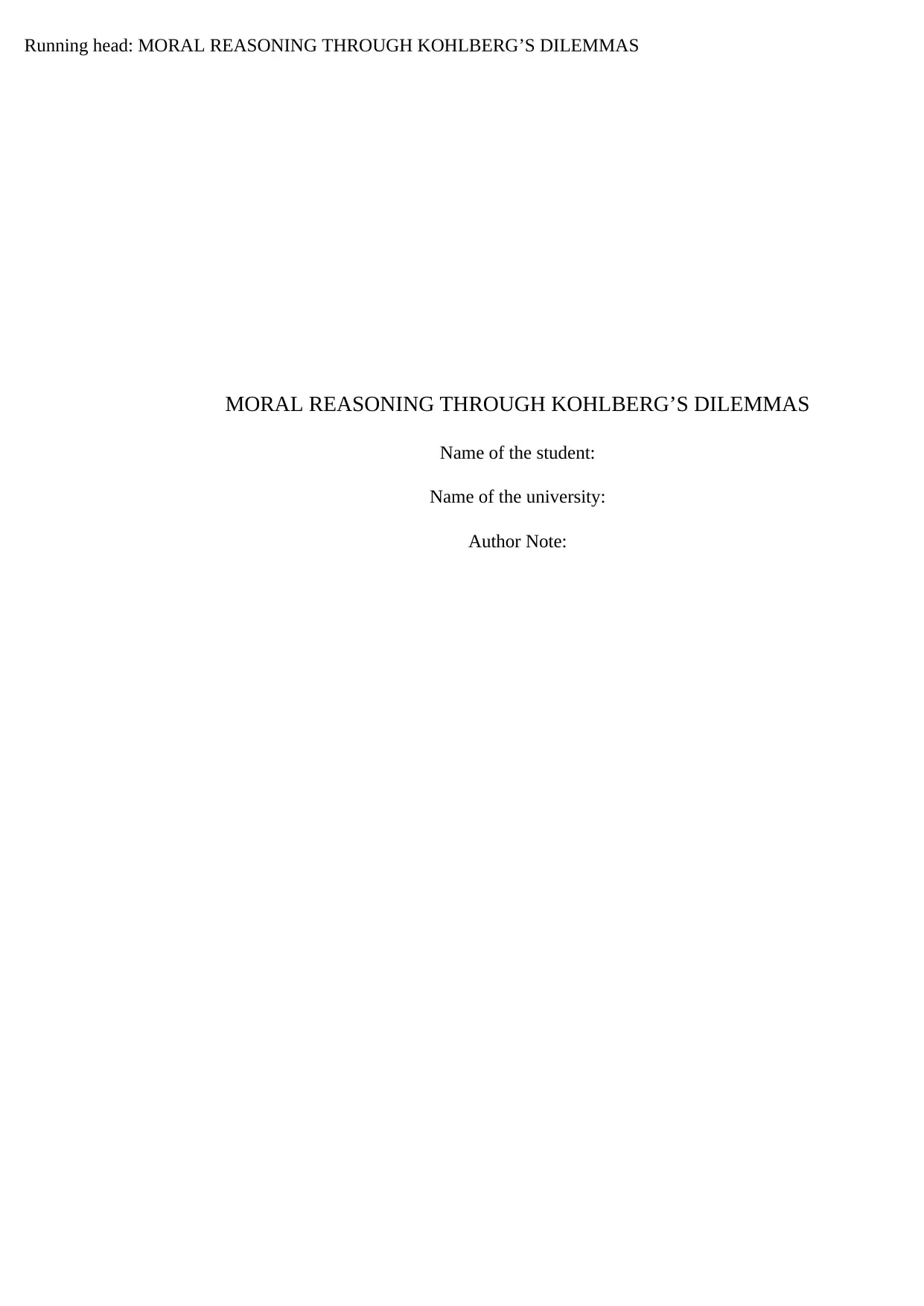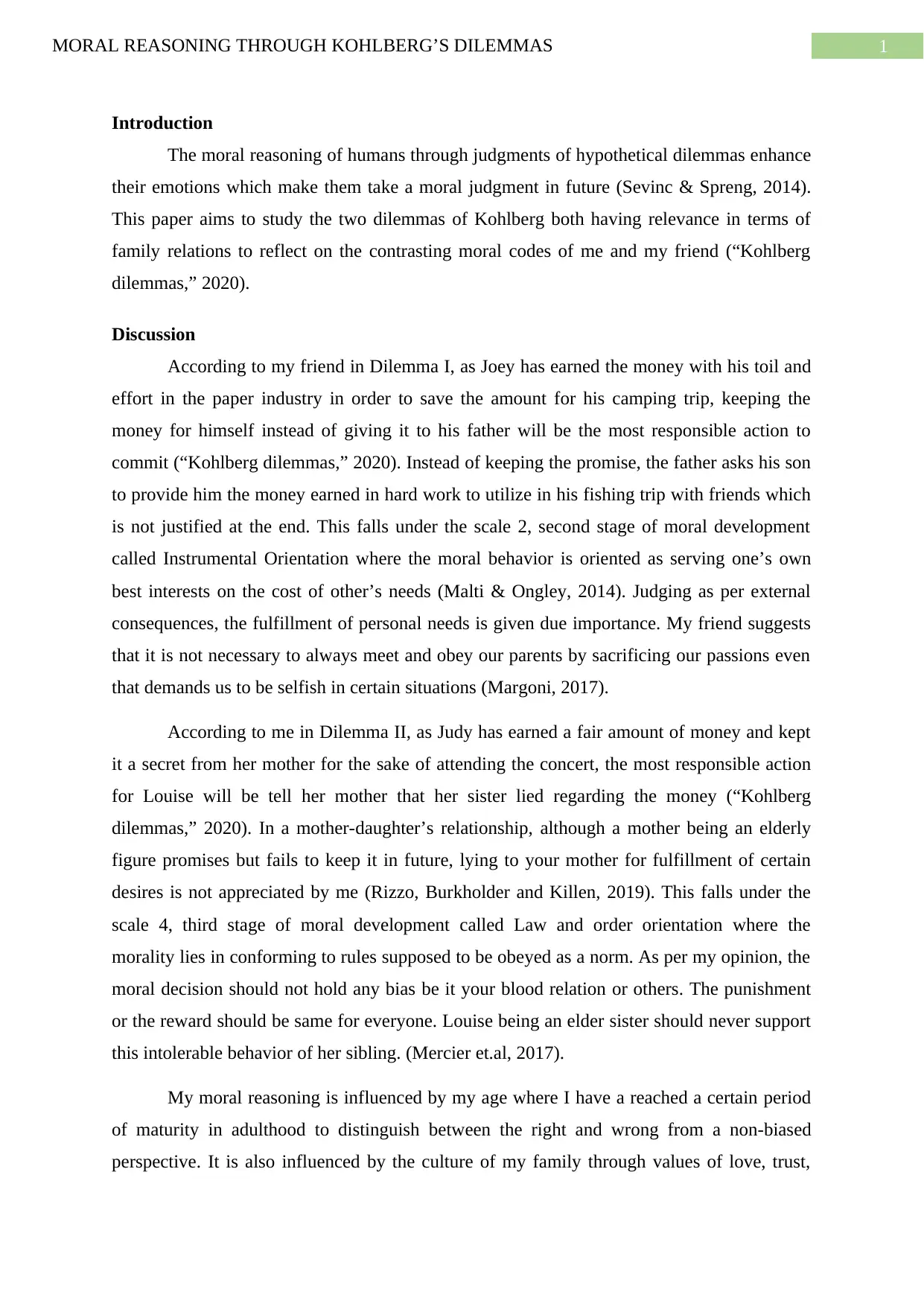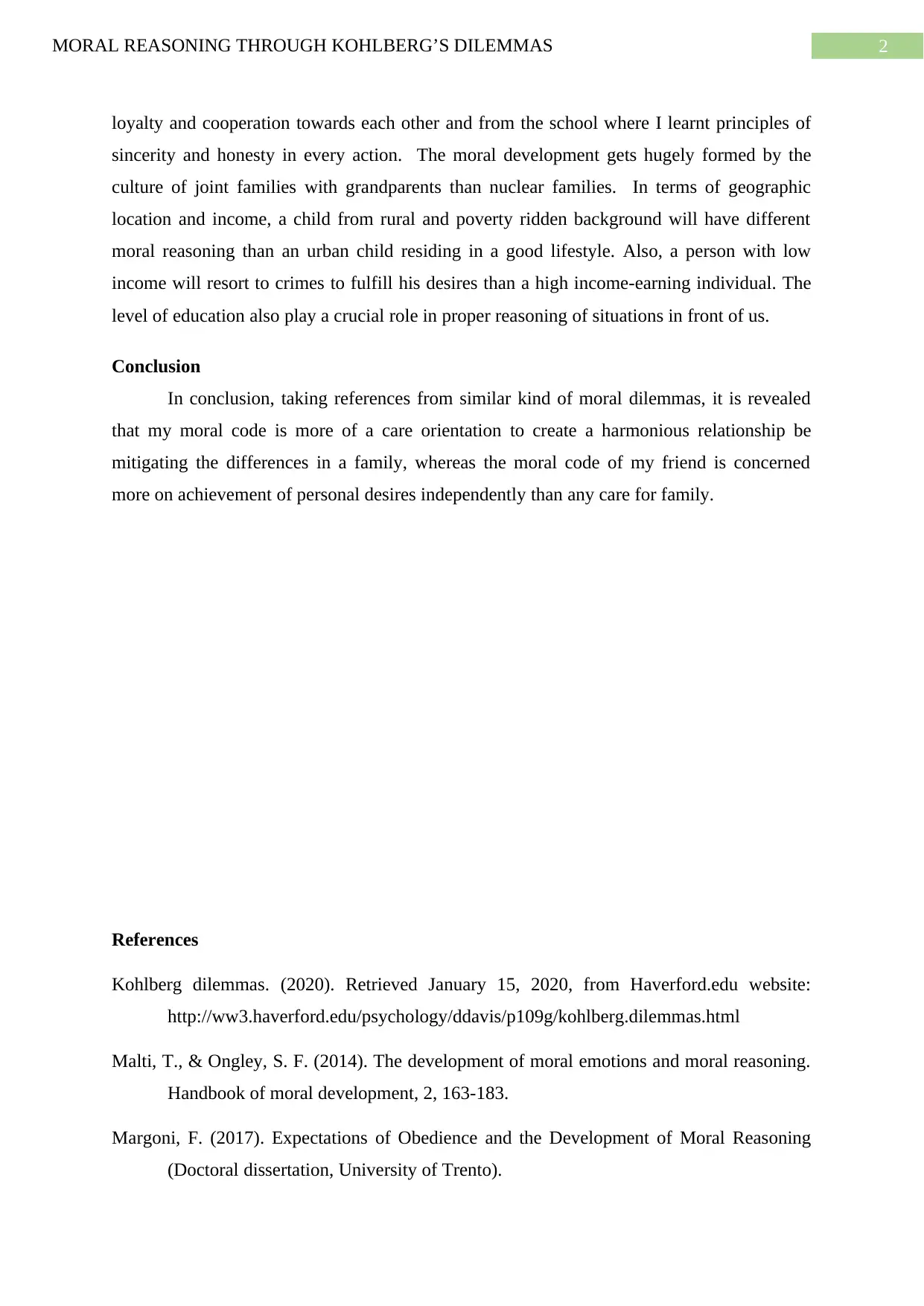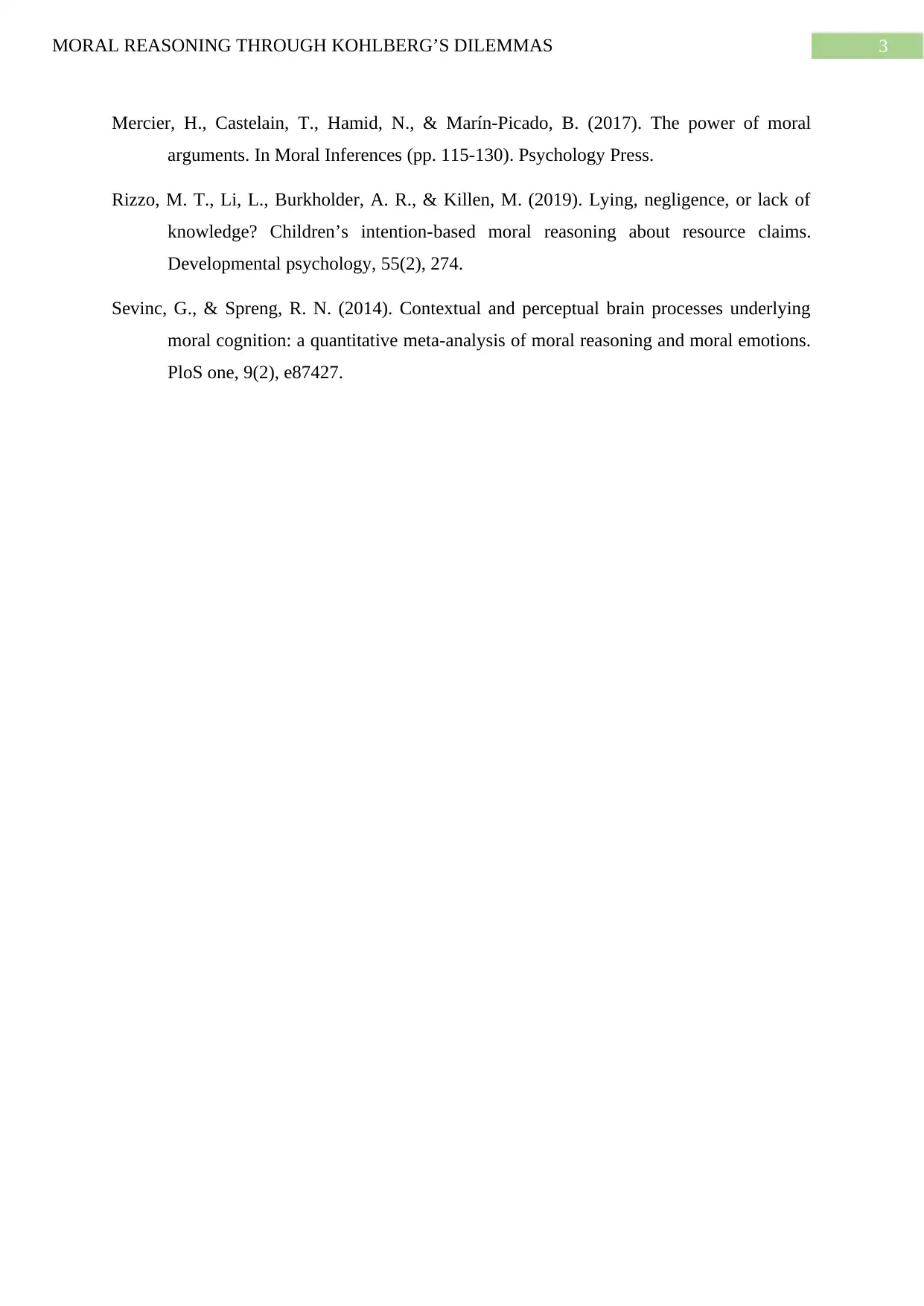Moral Reasoning Through Kohlberg’s Dilemmas Research Paper 2022
VerifiedAdded on 2022/08/26
|4
|945
|20
AI Summary
Contribute Materials
Your contribution can guide someone’s learning journey. Share your
documents today.

Running head: MORAL REASONING THROUGH KOHLBERG’S DILEMMAS
MORAL REASONING THROUGH KOHLBERG’S DILEMMAS
Name of the student:
Name of the university:
Author Note:
MORAL REASONING THROUGH KOHLBERG’S DILEMMAS
Name of the student:
Name of the university:
Author Note:
Secure Best Marks with AI Grader
Need help grading? Try our AI Grader for instant feedback on your assignments.

1MORAL REASONING THROUGH KOHLBERG’S DILEMMAS
Introduction
The moral reasoning of humans through judgments of hypothetical dilemmas enhance
their emotions which make them take a moral judgment in future (Sevinc & Spreng, 2014).
This paper aims to study the two dilemmas of Kohlberg both having relevance in terms of
family relations to reflect on the contrasting moral codes of me and my friend (“Kohlberg
dilemmas,” 2020).
Discussion
According to my friend in Dilemma I, as Joey has earned the money with his toil and
effort in the paper industry in order to save the amount for his camping trip, keeping the
money for himself instead of giving it to his father will be the most responsible action to
commit (“Kohlberg dilemmas,” 2020). Instead of keeping the promise, the father asks his son
to provide him the money earned in hard work to utilize in his fishing trip with friends which
is not justified at the end. This falls under the scale 2, second stage of moral development
called Instrumental Orientation where the moral behavior is oriented as serving one’s own
best interests on the cost of other’s needs (Malti & Ongley, 2014). Judging as per external
consequences, the fulfillment of personal needs is given due importance. My friend suggests
that it is not necessary to always meet and obey our parents by sacrificing our passions even
that demands us to be selfish in certain situations (Margoni, 2017).
According to me in Dilemma II, as Judy has earned a fair amount of money and kept
it a secret from her mother for the sake of attending the concert, the most responsible action
for Louise will be tell her mother that her sister lied regarding the money (“Kohlberg
dilemmas,” 2020). In a mother-daughter’s relationship, although a mother being an elderly
figure promises but fails to keep it in future, lying to your mother for fulfillment of certain
desires is not appreciated by me (Rizzo, Burkholder and Killen, 2019). This falls under the
scale 4, third stage of moral development called Law and order orientation where the
morality lies in conforming to rules supposed to be obeyed as a norm. As per my opinion, the
moral decision should not hold any bias be it your blood relation or others. The punishment
or the reward should be same for everyone. Louise being an elder sister should never support
this intolerable behavior of her sibling. (Mercier et.al, 2017).
My moral reasoning is influenced by my age where I have a reached a certain period
of maturity in adulthood to distinguish between the right and wrong from a non-biased
perspective. It is also influenced by the culture of my family through values of love, trust,
Introduction
The moral reasoning of humans through judgments of hypothetical dilemmas enhance
their emotions which make them take a moral judgment in future (Sevinc & Spreng, 2014).
This paper aims to study the two dilemmas of Kohlberg both having relevance in terms of
family relations to reflect on the contrasting moral codes of me and my friend (“Kohlberg
dilemmas,” 2020).
Discussion
According to my friend in Dilemma I, as Joey has earned the money with his toil and
effort in the paper industry in order to save the amount for his camping trip, keeping the
money for himself instead of giving it to his father will be the most responsible action to
commit (“Kohlberg dilemmas,” 2020). Instead of keeping the promise, the father asks his son
to provide him the money earned in hard work to utilize in his fishing trip with friends which
is not justified at the end. This falls under the scale 2, second stage of moral development
called Instrumental Orientation where the moral behavior is oriented as serving one’s own
best interests on the cost of other’s needs (Malti & Ongley, 2014). Judging as per external
consequences, the fulfillment of personal needs is given due importance. My friend suggests
that it is not necessary to always meet and obey our parents by sacrificing our passions even
that demands us to be selfish in certain situations (Margoni, 2017).
According to me in Dilemma II, as Judy has earned a fair amount of money and kept
it a secret from her mother for the sake of attending the concert, the most responsible action
for Louise will be tell her mother that her sister lied regarding the money (“Kohlberg
dilemmas,” 2020). In a mother-daughter’s relationship, although a mother being an elderly
figure promises but fails to keep it in future, lying to your mother for fulfillment of certain
desires is not appreciated by me (Rizzo, Burkholder and Killen, 2019). This falls under the
scale 4, third stage of moral development called Law and order orientation where the
morality lies in conforming to rules supposed to be obeyed as a norm. As per my opinion, the
moral decision should not hold any bias be it your blood relation or others. The punishment
or the reward should be same for everyone. Louise being an elder sister should never support
this intolerable behavior of her sibling. (Mercier et.al, 2017).
My moral reasoning is influenced by my age where I have a reached a certain period
of maturity in adulthood to distinguish between the right and wrong from a non-biased
perspective. It is also influenced by the culture of my family through values of love, trust,

2MORAL REASONING THROUGH KOHLBERG’S DILEMMAS
loyalty and cooperation towards each other and from the school where I learnt principles of
sincerity and honesty in every action. The moral development gets hugely formed by the
culture of joint families with grandparents than nuclear families. In terms of geographic
location and income, a child from rural and poverty ridden background will have different
moral reasoning than an urban child residing in a good lifestyle. Also, a person with low
income will resort to crimes to fulfill his desires than a high income-earning individual. The
level of education also play a crucial role in proper reasoning of situations in front of us.
Conclusion
In conclusion, taking references from similar kind of moral dilemmas, it is revealed
that my moral code is more of a care orientation to create a harmonious relationship be
mitigating the differences in a family, whereas the moral code of my friend is concerned
more on achievement of personal desires independently than any care for family.
References
Kohlberg dilemmas. (2020). Retrieved January 15, 2020, from Haverford.edu website:
http://ww3.haverford.edu/psychology/ddavis/p109g/kohlberg.dilemmas.html
Malti, T., & Ongley, S. F. (2014). The development of moral emotions and moral reasoning.
Handbook of moral development, 2, 163-183.
Margoni, F. (2017). Expectations of Obedience and the Development of Moral Reasoning
(Doctoral dissertation, University of Trento).
loyalty and cooperation towards each other and from the school where I learnt principles of
sincerity and honesty in every action. The moral development gets hugely formed by the
culture of joint families with grandparents than nuclear families. In terms of geographic
location and income, a child from rural and poverty ridden background will have different
moral reasoning than an urban child residing in a good lifestyle. Also, a person with low
income will resort to crimes to fulfill his desires than a high income-earning individual. The
level of education also play a crucial role in proper reasoning of situations in front of us.
Conclusion
In conclusion, taking references from similar kind of moral dilemmas, it is revealed
that my moral code is more of a care orientation to create a harmonious relationship be
mitigating the differences in a family, whereas the moral code of my friend is concerned
more on achievement of personal desires independently than any care for family.
References
Kohlberg dilemmas. (2020). Retrieved January 15, 2020, from Haverford.edu website:
http://ww3.haverford.edu/psychology/ddavis/p109g/kohlberg.dilemmas.html
Malti, T., & Ongley, S. F. (2014). The development of moral emotions and moral reasoning.
Handbook of moral development, 2, 163-183.
Margoni, F. (2017). Expectations of Obedience and the Development of Moral Reasoning
(Doctoral dissertation, University of Trento).

3MORAL REASONING THROUGH KOHLBERG’S DILEMMAS
Mercier, H., Castelain, T., Hamid, N., & Marín-Picado, B. (2017). The power of moral
arguments. In Moral Inferences (pp. 115-130). Psychology Press.
Rizzo, M. T., Li, L., Burkholder, A. R., & Killen, M. (2019). Lying, negligence, or lack of
knowledge? Children’s intention-based moral reasoning about resource claims.
Developmental psychology, 55(2), 274.
Sevinc, G., & Spreng, R. N. (2014). Contextual and perceptual brain processes underlying
moral cognition: a quantitative meta-analysis of moral reasoning and moral emotions.
PloS one, 9(2), e87427.
Mercier, H., Castelain, T., Hamid, N., & Marín-Picado, B. (2017). The power of moral
arguments. In Moral Inferences (pp. 115-130). Psychology Press.
Rizzo, M. T., Li, L., Burkholder, A. R., & Killen, M. (2019). Lying, negligence, or lack of
knowledge? Children’s intention-based moral reasoning about resource claims.
Developmental psychology, 55(2), 274.
Sevinc, G., & Spreng, R. N. (2014). Contextual and perceptual brain processes underlying
moral cognition: a quantitative meta-analysis of moral reasoning and moral emotions.
PloS one, 9(2), e87427.
1 out of 4
Your All-in-One AI-Powered Toolkit for Academic Success.
+13062052269
info@desklib.com
Available 24*7 on WhatsApp / Email
![[object Object]](/_next/static/media/star-bottom.7253800d.svg)
Unlock your academic potential
© 2024 | Zucol Services PVT LTD | All rights reserved.

